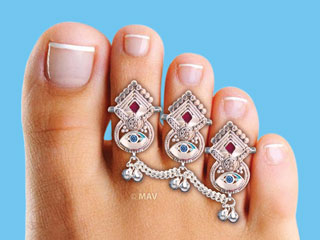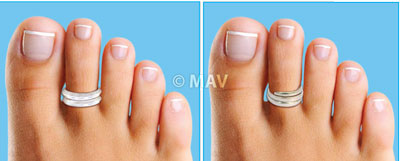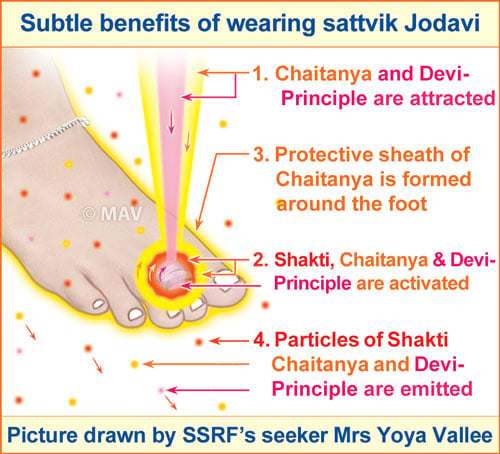Maharshi Adhyatma Vishwavidyalay conducts novel spiritual research to spiritualize daily life !
Invaluable research on spiritual healing remedies
Jewellery worn on feet such as anklets and toe-rings are cherished by women. Besides just looking good on the feet, they can also provide spiritual benefits that help the wearer at a more deeper level and are long lasting. In this article, we have explained the spiritual science underlying the benefits obtained from wearing sattvik jewellery on the feet.
One important factor that decides the sattvikta of jewellery worn on feet is that the jewellery should be made of silver. This is because the lower portion of the body performs functions such as excretion. Due to the Tama predominant waves generated from such activities, there is a greater possibility of the lower body coming under attack from lower-level subtle negative energies. These energies being less powerful, are able to attack from the ground region only up to the waist. Silver is Raja-Sattva predominant, therefore it is able to proactively combat such lower level distressing energies. Hence, expensive gold is not required.
Here we have presented an experiment conducted using the Universal Aura Scanner (UAS) to study the comparative effect of wearing a gold chain around the neck as well as an anklet.
1. Anklets

Anklets are a very popular form of silver jewellery worn around the ankles. They are worn by women right from childhood to late adulthood.
1 A. Spiritual benefits of wearing sattvik anklets
1. The silver metal in anklets attracts waves of Devi (Goddess) Principle charged with Tejtattva (Absolute Fire Principle). This Tejtattva and the sattvik sound waves emitting from the bells of the anklets protect the wearer from the attacks of subtle negative energies.
2. Anklets also attract waves of Shakti (Divine energy) and Kriya-shakti (Energy of action) from the Universe. Thus, a Raja predominant sheath is created around the body of the woman who wears the anklets.
3. The sattvik sound waves emitting from anklets also purify the environment.
1 B. Subtle process that takes place upon wearing a sattvik anklet

Note 1 : Subtle is that which is beyond the comprehension of the five senses, mind and intellect.
The true measure and analysis of what happens at the subtle level when we wear sattvik jewellery can only be understood through the advanced sixth sense. In the above subtle-picture, we have explained the subtle process perceived through advanced sixth sense that takes place when a woman wears sattvik anklets.
We can see in the subtle-picture how the anklet attracts flows of the Devi Principle and Chaitanya (Divine consciousness). These are then activated in the form of rings and create protective sheaths around the anklet and the foot of the wearer. A ring of Shakti is also activated in the anklet. Chaitanya and Shakti are emitted into the environment. It is apparent from the subtle-picture how wearing sattvik anklets benefits the woman as well as the surrounding environment.
1 C. Number of bells in an anklet
Some anklets have a lot of bells whereas some have only 1 set attached near the metal clip. Which type of anklets are more beneficial ? Well, the spiritual benefit depends on the age and marital status of the woman.
In young unmarried girls, Shakti is unmanifest. The Raja subtle component in the sound emanating from the many bells in the anklets helps awaken the unmanifest Shakti in the girl. This is why, wearing anklets with many bells is beneficial for young girls. However, in an adult or a married woman the Shakti is already in a manifest form. The mild sound emanating from limited number of bells awakens the Raja component to a limited extent. This keeps the fickleness and impatience in the woman (stemming from her increased Raja component) in check. Hence, in the case of an adult or a married woman, wearing anklets with limited number of bells is recommended.
2. Metal bands (Kadas) worn around the ankles
2 A. Silver kada

The trend of wearing a metal band, known as kada, is becoming increasingly popular.
Wearing a pure silver kada without any design or with a sattvik design provides a benefit of 10-20 per cent (compared with 100 per cent if an anklet is worn). However, nowadays wearing a kada of oxidised silver is considered more trendy. Since this metal is not sattvik, such kadas do not provide any spiritual benefit. On the contrary, they emit distressing vibrations into the environment.
2 B. Copper kada

In some parts, wearing a copper kada is quite prevalent.
Copper absorbs heat from the body. Also, since copper is a sattvik metal, it provides the benefit of Chaitanya too. Hence, those who have health problems due to excessive heat benefit from wearing a copper kada around wrist as well as the ankle. However, the spiritual benefit of wearing a silver anklet is much higher than that of wearing a copper kada. This is because silver is much more sattvik than copper.
3. Toe-rings
Since times immemorial, toe-rings have been worn in India by married as well as unmarried women. Here we have explained the spiritual science underlying the more prevalent types of toe-rings.
3 A. Jodavi
Jodavi is a toe-ring worn by married women on the second toe.
3 A 1. Spiritual benefits of wearing sattvik jodavi
A. The circular shape of jodavi has the ability to attract and store waves of Ichhashakti (Energy of will). These waves purify the Prana-deha (Vital body) of the woman.
B. The second toe emits Vayutattva. The awakened Shakti Principle in the woman through the medium of jodavi and with the help of this Vayutattva destroys subtle negative energies. Hence, the entry of subtle negative energies in the environment through the feet is prevented to the extent of 10 per cent.
C. Upon wearing jodavi on the second toe, positive energy is attracted to it. This energy flows through the woman’s Kundalini chakras and purifies her body.
D. When a woman wearing jodvi walks, Shakti is emitted into the environment in the form of particles. As a result Raja-Tama in the atmosphere is eliminated.
E. Jodavi worn during puja and religious rituals attract sattvikta, and thus, become even more sattvik.
3 A 2. Subtle process that takes place upon wearing sattvik jodavi
The above subtle-picture shows that upon wearing sattvik jodavi, Devi Principle, Chaitanya and Shakti are attracted towards it, which then gets activated in the form of rings. A protective sheath of Chaitanya is formed around the foot. Particles of Devi Principle, Chaitanya and Shakti are emitted into the environment and the woman’s body.
3 B. Masoli

Masoli is a fish-shaped toe-ring worn on the fourth toe of the feet. Traditionally worn by unmarried women, but sometimes also by married women, this jewellery is still quite popular.
3 B 1. Spiritual benefits of wearing sattvik masoli
A. Owing to the specific shape of the masoli, points on the toe are pressed. As a result, Acupressure takes place and reduces ailments of the wearer. It also destroys black energy stored in the woman’s toe.
B. Upon wearing masoli, the unmanifest Apatattva (Absolute Water Principle) in the fourth toe becomes manifest and activated.
C. The pressure on the ground while walking, as also the touch with the ground creates vibrations of Shakti. These are emitted and protect from the attacks of subtle negative energies from the Patal (Hell region).
3 B 2. Subtle process that takes place upon wearing sattvik masoli
In the above subtle-picture, we can see that flows of Chaitanya and Shakti are attracted to the masoli. They then get activated in the form of rings. Apatattva also gets activated in the form of a ring in the fourth toe. Shakti is then emitted into the body of the woman and the environment in the form of waves and particles. This dispels any negative energy in the surrounding environment.
3 C. Factors that decide the spiritual benefit obtained from toe-rings
3 C 1. Specific toe on which the toe-ring is worn
When an unmarried girl wears masoli on her fourth toe, her active Kundalini Shakti becomes unmanifest. As a result, her mind becomes calm and stable. Hence, she is able to lead a celibate life with ease.
When a married woman wears jodavi on her second toe, her Kundalini Shakti manifests and is activated. This gives her the required spiritual energy to fulfil her household duties and to lead a righteous married life.
This is why, it is essential for unmarried girls to wear masoli only on the fourth toe and for married women to wear jodavi only on the second toe.
3 C 2. Position of the toe-ring
Many women wear the ring in the middle of the toe. The point at the base of the toe attracts and activates the Sattva-Raja predominant vibrations in the jodavi the most. Hence, it is best to wear jodavi at the base of the toe. If they are worn higher, their benefit reduces.
3 C 3. Number of toe-rings worn
Nowadays, some women wear toe-rings on many toes. However, what is the ideal number of toe-rings ? It is beneficial for unmarried girls to wear a masoli on both their fourth toes. However, for married women it is enough to wear jodavi alone on both their second toes. Wearing any more toe-rings does not give any added benefit. On the contrary, it can be detrimental, because the additional toe-rings can obstruct the heat and Shakti emitting from the toes. As a result, distressing vibrations coming from the regions of Patal can collect around the toes and create a covering on the feet.
3 C 4. Shape and design of toe-rings

Any toe-ring can impart complete spiritual benefit only if its shape and design are sattvik. The round shape of the traditional jodavi is very sattvik. Hence, it gives maximum spiritual benefit. The fish shape of a masoli is rajasik. As a result, it imparts spiritual benefits only to a certain extent. Some sattvik shapes of toe-rings such as circular, diamond, flower, mango, swan shape that can be worn on the fourth toe are shown ahead.
Temple jewellery, such as a conch-shaped toe-ring (Last in second row), should not be worn since it has the God Principle. Hence, it is disrespectful to wear it on any part of the body.
3 C 5. Joined toe-rings

Wearing toe-rings joined with each other is slowly becoming prevalent. One such example is known as Pola (3 toe-rings joined together with chains and worn on 3 toes). It is not recommended from a spiritual perspective since it does not provide any spiritual benefit because wearing rings on toes other than the second and fourth toe-ring is not beneficial spiritually.
3 C 6. Joined anklet and toe-ring

Wearing two different jewellery pieces in combination is becoming prevalent world-wide. A similar item of jewellery is an ankle bracelet.
It consists of an anklet and a toe-ring which are joined together by a chain. These two jewellery items perform different functions at the spiritual level. By joining them, their vibrations get mixed and their ability to provide spiritual benefits reduces. Thus, it is spiritually inappropriate to wear such jewellery.
4. Tarnishing or breaking of anklets or toe-rings
Tarnishing or breaking of anklets or toe-rings is something women have experienced at some time or the other. This happens due to a variety of known physical causes such as corrosion of the metals from which the jewellery is made. However, there is another cause of tarnishing or breaking of jewellery which is unknown to most of us, and that is – the adverse effect of subtle negative energies. In the case of the following situations, we can think of negative energies as being the cause of the damage to jewellery.
A. New jewellery is tarnished or broken.
B. Jewellery is tarnished without exposure to any corroding agents.
C. Jewellery is found to be broken without any physical cause.
Ongoing spiritual practice is the best method of protecting ourselves as well as our jewellery from the adverse effect of subtle negative energies.
– Paratpar Guru (Dr.) Athavale (Founder, Maharshi Adhyatma Vishwavidyalay) and Dr. (Mrs.) Nandini Samant (Maharshi Adhyatma Vishwavidyalay Research Team Member, Goa.)
E-mail : mav.research2014@gmail.com





 When and how much should one sleep ?
When and how much should one sleep ? What is the ideal position for sleeping ?
What is the ideal position for sleeping ? How to fall asleep fast?
How to fall asleep fast? For healthy living avoid food that can cause antagonism due to contra-indications
For healthy living avoid food that can cause antagonism due to contra-indications Yog-vidya which bestows mental peace and healthy life !
Yog-vidya which bestows mental peace and healthy life ! Realise the power of water and make full use of it
Realise the power of water and make full use of it
Kindly explain about black threads ties up trend now Is it good according to our Hindu dharma is it really evil or negative destroyer ……!!
Namaskar Shwetha ji,
Instead of opting for such threads, a person should always give priority to doing sadhana (spiritual practice). By performing spiritual practice sincerely and consistently, a subtle protective sheath of the Deity is formed around us.
To learn how to perform spiritual practice, visit – https://www.sanatan.org/en/start-your-spiritual-journey
You can also join our online satsangs by registering (for free) here – https://events.sanatan.org/
Namaste,
I am a student who is inclined to Occult Science and their practices.
Off late, I was referring to Accupressure Subject and got to know about Meridian points and it’s role in our Body.
While being more inquisitive and to relate with our Sanatan practice and few scriptures I notice that there has been practice of wearing Jewellery or a simple Bracelet made either out Brass/Copper/Silver/Gold and also notice that those were bit thick and weighted.
In pursuit to gather more information, I landed in this page which highlights about women wearing Toe Ring.
Sir/Madam, I am more interested to understand that is it only specific to women to wear Toe ring, why can’t men?
The points in the foot is also similar but why men wearing toe ring hasn’t been mentioned?
Looking forward for your insight on this regard.
Namaste.
Namaste Vijay ji
Thank you for contacting us.
In the earlier times, there was a tradition for men to wear ornaments; however, in the present Era, most men abstain from wearing ornaments. Our seekers received the following knowledge from the subtle dimension regarding this. Shivatattva (Principle of Deity Shiva) has adorned this vast illusory world, and men represent that Principle. Shivatattva in the form of detachment works with the support of Māyā, but does not imbibe it. Since ornaments are a symbol of attraction, men generally abstain from wearing them. So this is the spiritual reason for why men wear fewer ornaments.
Also, since you said you are spiritually inclined, could you share if you are following any spiritual path currently?
Warm regards
Sanatan Sanstha